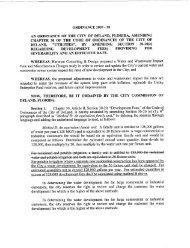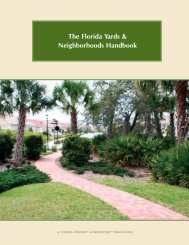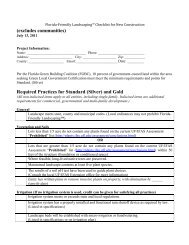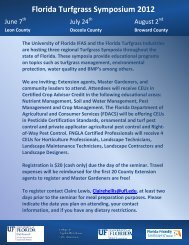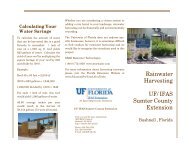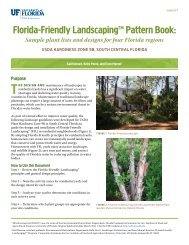A Guide to Florida-Friendly Landscaping A Guide to Florida-Fr ...
A Guide to Florida-Friendly Landscaping A Guide to Florida-Fr ...
A Guide to Florida-Friendly Landscaping A Guide to Florida-Fr ...
Create successful ePaper yourself
Turn your PDF publications into a flip-book with our unique Google optimized e-Paper software.
Tom Wichman 1 , Gary Knox 1 , Ed Gilman 1 , David Sandrock 2 , Bart Schutzman 1 , Erin Alvarez 1 , Rick<br />
Schoellhorn 3 , and Barbra Larson 1<br />
1 Dept. of Environmental Horticulture, University of <strong>Florida</strong>, Gainesville, FL; 2 Oregon State University, Corvallis, OR; 3 Proven<br />
Winners, Gainesville, FL<br />
<strong>Florida</strong>-<strong><strong>Fr</strong>iendly</strong><br />
Plant List<br />
2006<br />
The plants on this list are considered by UF/IFAS horticulture specialists <strong>to</strong> be well adapted <strong>to</strong> growing<br />
in <strong>Florida</strong> landscapes. When planted under appropriate soil, light, and climatic conditions, most<br />
generally require little maintenance compared with other plants. Each plant’s preferred growing<br />
conditions (soil pH, soil texture, relative drought <strong>to</strong>lerance, soil drainage/moisture, light range, light<br />
optimum, and salt <strong>to</strong>lerance) are included here as a guide <strong>to</strong> choosing plants for your specific site<br />
conditions. Additional information is given on growth rate, mature height and spread, flowering color<br />
and season, value <strong>to</strong> wildlife, wind resistance and other characteristics helpful for plant selection and<br />
maintenance.<br />
See the key <strong>to</strong> symbols and abbreviations used in the tables for details. Remember <strong>to</strong> always put the<br />
right plant in the right place by matching each plant’s needs with the environmental conditions found at<br />
the site. There may be variation in some characteristics, especially in the region (north, central or<br />
south) of <strong>Florida</strong> in which plants will grow. Check with your county’s UF/IFAS Extension office <strong>to</strong><br />
confirm the appropriateness of specific plants (look in the government pages of your phone book or see<br />
http://solutionsforyourlife.ufl.edu/map for your county’s contact information).



